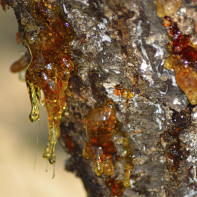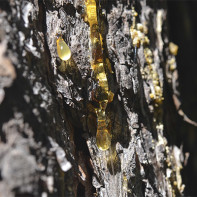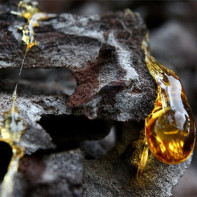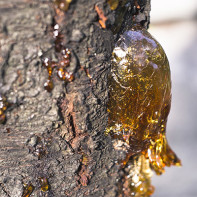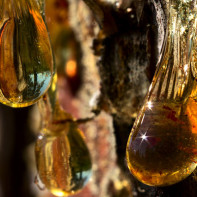Pine oleoresin: therapeutic properties and contraindications
Pine is one of the most common coniferous trees. It has great importance in the national economy. The wood of this tree is characterized by good technical indicators. Compared to larch, pine timber is light and easier to process. At the same time, it is very durable. Pine timber is widely used in construction, furniture production. Due to the ease of processing, it can be used to make furniture and furnishings of unusual bizarre shapes.
- Chemical composition
- Harvesting and storage
- Therapeutic properties of pine oleoresin
- Pine oleoresin in folk medicine
- Ointment for eczema and trophic ulcers
- Ureemic ointment for varicose veins
- Ointment for burns
- Healing composition for sciatica and joint diseases
- Infusion for sexual impotence
- Ulcer Treatment
- Treatment for hernia between the vertebrae
- For boils
- For immunity and acute respiratory viral infections
- Other Recipes
- Oleoresin based products
- Cosmetic applications
- Contraindications for use
- Industrial processing of oleoresin
- Purification
- Boiling
- Uses
Pine can also be called an amber tree. It is considered to be the ancestor of this unique and most beautiful creation of nature. Amber is the petrified resin of conifers, primarily pine trees. This stone is used not only in jewelry, but also in industry to produce insulators, varnishes, and even some physical and medical devices.
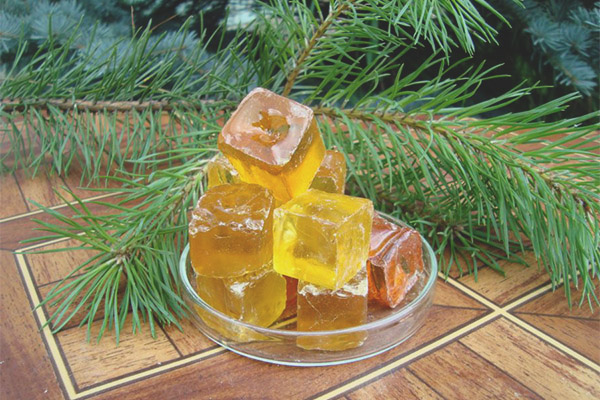
The dry distillation of wood produces tar, which is used to heal wounds. Charcoal is used in the technical field to absorb gases and liquids. Activated charcoal obtained through processing is used in medicine for poisoning.
Decoctions of unopened buds are used as an expectorant and disinfectant. Infusions of pine needles are considered a preventive and therapeutic agent against scurvy. Navigators used pine needles as the only source of vitamin C during the long voyage. Now they make vitamin meal from it, which is used in agriculture and animal husbandry. Coniferous extract has found use in medicine, cosmetology, and perfumery.
But pine resin, or oleoresin, is considered to be the most miraculous, curing a huge number of ailments.
Oleoresin, or turpentine, is a resinous aromatic substance secreted by coniferous trees due to metabolism and when the integrity of the bark is broken. When cured, this substance protects the damaged area from pathogens and other pests due to its content of antibacterial and antifungal substances. It is these that originally determined the healing power of oleoresin.
This is interesting! During the war years with an acute shortage of medicines it was with the help of oleoresin that thousands of wounded were saved.
As a child, many chewed fragrant clots, not even knowing what benefits they bring to the body.
Chemical composition
Oleoresin contains vitamins A, C, D, E, K, minerals: iron, phosphorus, manganese, iodine, potassium, calcium, silicon, zinc. Also present in the resin are fatty acids, succinic acid, carotene, resinous esters, and alcohols (gums).
Oleoresin consists of 75% resinous acids. They are solid, but with the help of natural solvents called terpenes, resin, like blood in the human body, can move freely inside the tree trunk. Neutral substances, the presence of which makes pine resin therapeutic, account for up to 20% of the entire mass of the oleoresin.
Harvesting and storage
Since ancient times, people have extracted oleoresin. In industrial quantities extracted and processed it began in the 50's of last century in the Altai. Turpentine and colophony were produced from it.
Turpentine obtained from pine resin is distilled to produce camphor. It is a component of many medicines. Rosin, produced by boiling the resin at 170°C, is used in soldering, plastics, rubber, linoleum, glue, soap. Turpentine and rosin are excellent starting materials, and for some products they are the only possible raw materials.
Oleoresin of coniferous trees is also collected for personal use. Collection can be done all year round. In winter, oleoresin is in a hardened state. To collect the hard resin you will need a jar with a lid, a knife and a cloth soaked in vegetable oil. It is not recommended to collect oleoresin near roads or industrial plants, because trees can accumulate harmful substances and heavy metals. You need to find a pine tree with drops or drips of resin. Then a knife, wiped with oil, carefully cut off the oleoresin and drop it into a jar. Wipe the knife after each use, as the resin is very sticky.
Fresh transparent oleoresin is better to collect from early spring, when the sap starts to flow, until the fall. Going to the forest, you must arm yourself with a knife, a rope and a jar with a lid. On a young tree, make an incision under the branch that is as deep as the thickness of the bark. The length of the cut should not be more than 5-6 cm. Under the incision, fix a jar with a rope. In it you can pour a little sunflower oil, so that the oleoresin remains in a liquid state. For a faster collection of resin is better to make several cuts at about 45 degrees c two sides, which converge in one line. The initial release of resin is usually quite sparse. After a week the incisions should be cleaned, causing the next secretion, which is much more intense. During the summer period, it will be possible to collect about 0.5 liters of resin from each tree.
For convenience, you can use improvised means to make an uncomplicated trough, for example, from a plastic bottle. It should be tightly fastened under the notch, and already under it tie a can. This will prevent the resin from leaking past the jar. The container for collecting oleoresin should be glass or ceramic. The metal should never come into contact with the resin, neither in the collection, nor in the further preparation of various medicines. The fact is that the resin reacts with the metal, thus changing its chemical composition. This can affect the quality of its derivatives.
It is better to collect oleoresin in warm sunny weather. The higher the atmospheric temperature, the better the trees give resin, because it is in a more liquid state. Such oleoresin is more useful.
Oleoresin is also collected by pricking pockets of resin. Pine is different from other conifers and hardly ever forms such pockets.
Some people think that collecting resin is very damaging to trees. It doesn't. The cut is quickly healed with its own resin, so pests cannot get into the wound. The formation of renewed resin is rapid, similar to the human body's hematopoiesis, and soon returns to normal.
The hardened oleoresin can be stored for quite a long time. If you do not plan to make something from fresh liquid resin at once, you can pour it into small molds and let it solidify. Then, taking small pieces out of the form, put them in a vessel for storage. In this case you do not have to chop off the hardened large piece the right amount of resin, just take a small piece and make a remedy from it.
But more often, the oleoresin is immediately used to prepare a balsam, warming it with a water bath together with any vegetable oil until a homogeneous consistency is obtained. The choice of oil depends on the effect to be obtained. For example, sea buckthorn oil will contribute even faster healing, burdock oil will strengthen the hair even more and accelerate its growth. You can make the whole balm with sunflower oil, and before using it, you can add the necessary oils. The concentration, too, everyone chooses for himself. If you take 100 g of resin and 100 g of oil, you get 50% balsam, 50 g of resin - 25%. Balsam should be stored in glass jars, closed with a lid, at a temperature of about 200 ° C. Duration of storage of balm is limited only by the shelf life of oil. For solid oleoresin in pure form, the shelf life is not limited.
Therapeutic properties of pine oleoresin
The main known therapeutic quality of oleoresin is its healing properties. It promotes healing of cuts, burns, is especially effective for burnt wounds, can draw pus and disinfect the affected area. But the healing effect of the properties of pine oleoresin is not limited. The spectrum of its therapeutic effect is very wide:
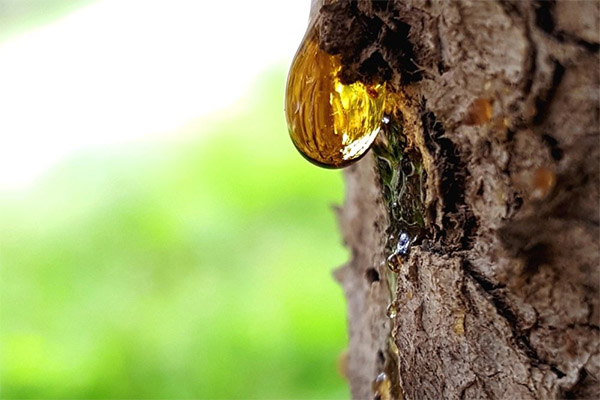
- Inflammation of the respiratory tract, colds and viral diseases. Due to anti-inflammatory properties, it successfully treats pneumonia, flu, bronchitis, coughing helps expectorate sputum.
- Diseases of the mouth and gums. It is used for mouthwashes. It disinfects and relieves inflammation of the mucous membranes.
- Radiculitis and inflammation of the joints. With arthritis, osteochondrosis, arthrosis, ointments and creams containing pine oleoresin rub into the painful inflamed area. They reduce inflammation, reduce pain and discomfort.
- Pathologies of the gastrointestinal tract. Consumption of oleoresin has beneficial effects on the intestinal flora, normalizes the function of the liver and pancreas, the process of bile formation, restores the mucous lining of the stomach, regulates the release of gastric juice, heals inflammation and ulcers. To achieve maximum effect in the treatment of diseases of the gastrointestinal tract is recommended to use balms of oleoresin and sea buckthorn oil.
- Diseases of the heart and blood vessels. Pine oleoresin balms thin the blood, prevent the formation of blood clots, strengthen the walls of blood vessels and increase their elasticity, normalize venous outflow, improve blood supply to the brain, regulate blood pressure.
- Disorders of the nervous system. Oleoresin improves mental and physical performance, reduces irritability, helps with headaches, normalizes sleep, serves as an antidepressant, eliminates the feeling of constant fatigue.
- Diseases of the genitourinary organs. In diseases of the kidneys, inflammation of the urinary tract, prostatitis take oleoresin balm with cedar oil. Pine oleoresin and medicines containing it make the recovery process faster due to the diuretic and anti-inflammatory action.
- Skin diseases. Oleoresin is a natural antibiotic and antiseptic, disinfects and disinfects the injured or damaged skin. It accelerates the processes of epithelium repair when it is disturbed due to a disease. The skin heals without visible residual scars and scars.
- Diseases of the endocrine system. When inflammation of the thyroid gland also use oleoresin. It also reduces sugar levels in diabetes, it contributes to this succinic acid.
Pine oleoresin in folk medicine
Nature herself has told people that pine oleoresin is a healing agent. Any damage or cut on the tree poses a threat to the existence, growth and normal development of the plant. Trees themselves protect and heal themselves with the healing resin, releasing it from the damage. People noticed this and also began to use the pine resin for their treatment.
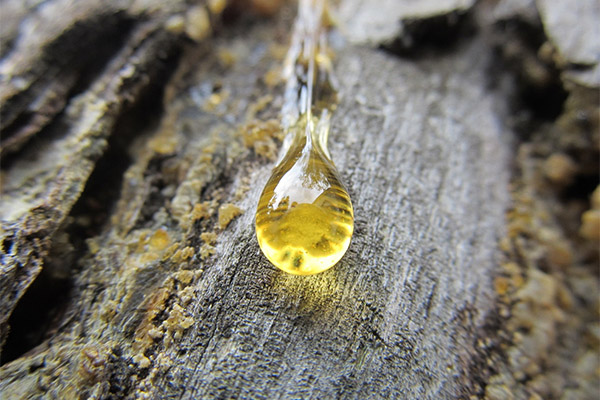
In folk medicine, there are two ways to use pine oleoresin: internal and external use. For external use use a variety of oils, lotions, compresses, ointments, rubbing. Inside take ready-made balms, decoctions, infusions. The resin can simply be sucked up like a lollipop.
There are a great many recommendations and recipes for the use of pine oleoresin. Here are some of them.
Ointment for eczema and trophic ulcers
Take 100 grams of beeswax, 100 g of internal pork fat and 50 g of oleoresin. Warmed with a water bath and mixed. Apply to the problem area once a day. It is better to do it at night, having previously treated the damaged place with hydrogen peroxide.
Extract for the treatment of varicose veins
Pine oleoresin and any vegetable oil are mixed in a ratio of 1:10. The mixture is well heated and cooled. Once a day, the sore spots are smeared, preferably before going to bed.
ointment from burns
Take in equal parts pine resin, internal pig bacon, sea buckthorn oil. Everything is mixed until a homogeneous consistency. The ointment is applied for one hour, cover with a bandage. It is desirable to repeat at least three times a day.
Therapeutic composition for sciatica and joint diseases
Equal parts of vodka, olive oil and pine oleoresin mixed until smooth. The mixture insist a week in a cold place. Inflamed areas are rubbed with this infusion.
Infusion of sexual impotence
Pour 1 teaspoon of crushed pine resin 0.5 liters of vodka. The mixture is infused for 5-7 days. Take an infusion of 2-3 tablespoons in the afternoon and evening.
The treatment of peptic ulcer
Prepare a 10% balm in sea buckthorn oil. In the morning, before meals, take 1 teaspoon.
Means for the treatment of hernia between the vertebrae.
Need 500 g comfrey root, 70 g of pine resin, 350 grams of blubber and 300 grams of vodka. Thoroughly washed roots are ground with a mincer several times, mixed with grease, simmer for 40 minutes. Then add the liquid resin, vodka and simmer for another 5 minutes. Cool and apply to the sore spot.
For boils
In its pure form, oleoresin will help to cure boils. It is applied to a small piece of bandage or gauze, applied to the boil and fixed with a plaster. Treatment is continued for 2-4 days. The boil disappears without a trace.
For the immune system and in case of acute respiratory infections.
It is recommended to cool a piece of oleoresin well, crush thoroughly and take three times a day with cold water. This will strengthen the immune system, will help with colds.
When coughing and runny nose, you should rub oleoresin balm on the wings of the nose and nose bridge, rub the chest and feet.
Other Recipes
If you masticate a piece of oleoresin as a candy, heartburn will disappear, stomach pain will be reduced. Thus, you can relieve toothaches, heal wounds on the gums and mucous membranes, freshen the breath.
There is scientific evidence of the effect of oleoresin in cancer: it reduces the resistance of tumors to radiation and chemotherapy.
For a long time, pine oleoresin has been considered an effective tool for weight loss. Taking 10% balm at night cleanses the body of toxins. Rubbing with oleoresin oil in the bath promotes fat burning. Very good results are shown by the so-called Siberian diet (about it now a lot of people write and speak).
Rubbing pine oleoresin balm into the skin, you can protect yourself from blood-sucking insects for a few hours. When bitten, balm relieves burning and itching.
Preparations based on the oleoresin
After studying all the properties of pine oleoresin, scientific medicine has recognized its healing qualities. Pharmacists use the resin in the manufacture of medicines.
After purification turpentine is widely used in traditional medicine, it is a part of ointments for joint and spine pain, it is used to prepare turpentine baths, it make inhalations at inflammation of the respiratory tract. The rosin, on the other hand, is used only in industry.
From oleoresin oil is produced olimethine - a substance used to get rid of cholelithiasis.
In the pharmacy you can buy oleoresin in pure form. To enhance the therapeutic effect, medicinal herbs and plants, various oils are added to the oleoresin:
- Artichoke. Used in diseases of the kidneys, liver, relieves intoxication, swelling, normalizes metabolism.
- Aloe. Beneficial for the skin, heals inflammation and wounds.
- Badger fat. Used for colds and bronchitis. Rubbed into the chest before bedtime.
- Shilajit. Heals bone tissue in fractures, helps with bruises. When the inside gets rid of gastrointestinal problems.
- Propolis. Tones the body, protects the immune system, and relieves depression.
- St. John's wort. Gargles help with stomatitis. Outwardly used for the treatment of skin diseases. Through internal use struggles with fatigue.
- Cinquefoil. Strengthens muscles and joints, reduces pain during movement.
Cosmetic use
For the skin is recommended to use oleoresin balm containing resin 15-20%. With any type of skin absorption balm is equally good. It gives the skin elasticity, softens it. Balm also keeps it moisturized, heals small wounds, relieves itching and redness, soothes irritation. With the help of pine oleoresin balm can easily remove makeup, it gently removes all the dirt and cosmetics from the skin.
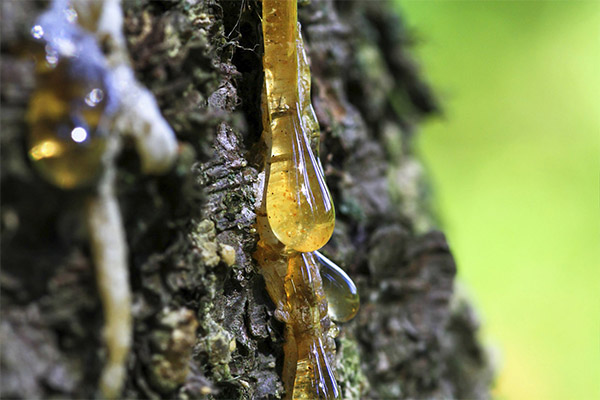
- Pine oleoresin balm can be used instead of a night cream for the face. It is recommended to lubricate the skin an hour or two before bedtime to allow the balm to absorb.
- With oleoresin oil is mixed with peach or jojoba. It all depends on the desired effect in a particular case.
- To get rid of acne and pimples, use oleoresin balm with tea tree oil (just add a few drops). Rub the face 3 times a day. The effect is not long in coming.
- With the use of oleoresin noticeably reduces the number of wrinkles, smoothens the skin. Natural nutrition gives the skin a healthy look. If it is difficult to refuse your favorite cream, you can add a few drops of oleoresin balm. The result will be noticeable almost immediately.
Also make facial masks:
- Take 2 tablespoons of honey and the same amount of 5% oleoresin balsam, all mixed. Apply to cleansed skin and leave on for 5 minutes. Then rinse with lukewarm water.
- You can warm (in no case hot) 5% pine balsam applied to the neck and face, cover with a cloth soaked in warm water or a towel. After 7-10 minutes rinse with water. In the warm state oleoresin is better absorbed into the skin and nourishes it.
- For eyelashes is also worth doing a mask: 1 part pine oleoresin melt in a water bath with 3 parts of burdock oil. Massage the eyelashes gently. Rinse off after 30 minutes with warm water. Your eyelashes will become noticeably thicker and longer.
- For the lips is useful rubbing 5% turpentine oil, you should first massage the lips with a brush in a gentle circular motion. It is also useful to apply a mask to the lips of gum oil and honey 1:1 for 10-15 minutes.
Weak and brittle hair can also be easily treated. Before washing, you should massage the roots with your fingers soaked in 5% pine balsam. Then apply the balm to the entire length of the hair. To better absorb the balm, you can hold the hair over steam and rub it. It is recommended to wash your hair after 20 minutes. Oleoresin renews cells throughout the hair, balm nourishes and moisturizes the scalp. Hair becomes healthier and grows better. Pine balm and aloe juice mask has a positive effect on the hair. It stops hair fall, reduces hair breakage and strengthens the hair.
Lotion prepared on the basis of oleoresin balsam will effectively take care of the beauty of the neck. It can be kept in the refrigerator for a while. Mix 5 tablespoons of 5% turpentine balsam, lemon juice, egg yolk and 1 tablespoon of vodka. Apply the lotion with a cotton pad to the neck and the area around it for 15-20 minutes, then rinse with water.
The skin of the hands requires special treatment, as it is constantly under the influence of detergents and cleansers, wind, rain, frost. Before using the balm it is necessary to give your hands contrast baths, alternating between cold and hot water. Then rub into the skin of hands 5% turpentine balm massage motions, starting from the fingertips. After rubbing it is useful to massage your hands. If there are small cracks on the fingers, you need to rub them overnight with 25% pine balm and wear cotton gloves.
If your nails are brittle, it is recommended to rub into them 25% turpentine balsam. The more often it happens, the better.
Foot care can be carried out according to the standard scheme, as who is used to, only the means should be replaced by turpentine balm. The balm should be rubbed after any water procedures as long as the skin of the feet will be able to absorb it. From cracks on the heels get rid of so: you need to mix 25% oleoresin balsam with honey in a ratio of 1:1, apply it to a cloth napkin, put it on the heel, cover with cellophane and fasten the bandage. After removing the hair is recommended to lubricate the skin 5% pine balsam.
Baths with balsam are also beneficial for the body. It is necessary to take a bath of water 36-37 ° C and add to it 10-15 drops of turpentine balsam, stir. The temperature should be comfortable for the body, not too hot and not too cold. Taking a bath with pine balsam is not only a pleasure. Grieve minor injuries on the skin, it will become softer, absorb useful substances. Bath will strengthen the nervous system, normalize sleep. Salts and various herbs can be used together with the balm.
The same bath can be done separately for the feet or hands. Only for the feet should be a little cooler water, and for the hands - warmer.
Contraindications to use
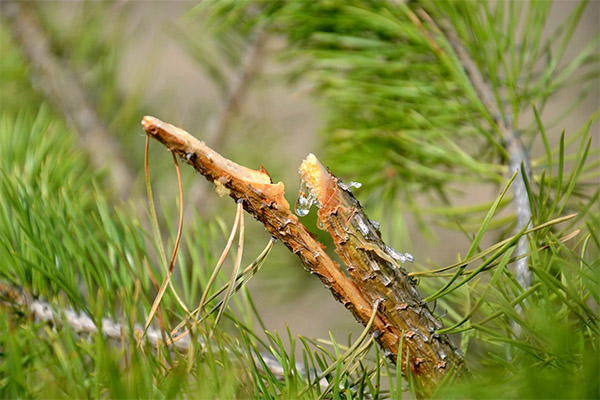
Oleoresin, as well as preparations based on it, has almost no contraindications. The only contraindication is intolerance to the resin and its components. To know a person's reaction to oleoresin, you should put a small amount of it on the back of your forearm. If after a while there will be no redness and itching - then there is no allergy. You can safely use pine resin and products from it outwardly and used internally.
It is not recommended to use resin in children under 10 years, pregnant women and nursing mothers.
With a variety of renal diseases also contraindicated oleoresin.
Industrial processing of oleoresin
Industrial processing of oleoresin produces turpentine and rosin. Pine resin is processed according to the standard technology. There is only a slight difference in parameters due to differences in density and viscosity of the oleoresin components.
At the moment of collection, pine resin consists of 35% of terpene hydrocarbons, which are called turpentine. The turpentine content decreases when it comes into contact with air during preparation for loading and transportation to the processing plant. When turpentine is lost, the turpentine solidifies and becomes barras. This makes it difficult to process and negatively affects the quality of the final products. Try to process barras together with oleoresin, adding it in small quantities.
Oleoresin processing consists of two stages. At the first stage the resin is purified from impurities and water, and turpentine is obtained. At the second stage, turpentine is separated into resin acids and volatile turpentine hydrocarbons, or turpentine. In this process, acids fuse with other non-volatile components of oleoresin. The resulting product is called rosin.
Purification
Oleoresin contains water and various large and small impurities. Poor purification not only changes the color of rosin, but also deteriorates its quality. It is impossible to separate impurities from the resin at medium temperature. Its viscosity is reduced by heating. Then the impurities are filtered out, and water is removed by sedimentation.
Resin in which there is about 14% turpentine has a higher density, so the water will sag from the top. If the fraction of turpentine is 25% at any temperature, the turpentine is lighter, and the water will be at the bottom. If the turpentine in turpentine contains more than 25%, the density of water and turpentine is almost the same value, they separate very long.
In oleoresin, which is brought to the plant, the content of turpentine is about 18%, so it is impossible to separate the water by sedimentation. It is necessary to increase the temperature and increase the difference between the density of resin and water. The density of water is easy to increase by adding salts, the density of oleoresin is reduced by adding turpentine or other solvent. Then the process of settling will help to separate the water.
Boiling
The process of separating the volatile and non-volatile components of pine oleoresin is called boiling.
Separation of turpentine from turpentine should be done at the lowest possible temperatures. Some impurities may remain in turpentine after purification. At high temperature, they will begin to decompose. The decomposition of rosin constituents will begin at temperatures above 200°C. The decomposition products will give the turpentine a pungent smell and change its color, and the rosin will give it a dark color and stickiness. Pure turpentine boils at 156°C, but the content of resin acids leads to an increase in this temperature.
Separation of turpentine will increase the concentration of acids and the boiling point in the remaining turpentine. Therefore, separation of turpentine from turpentine is not possible at normal atmospheric pressure. Of the various methods, the one that is easiest to carry out was chosen: separation with water vapor. It is based on the fact that the boiling point of a mixture of liquids that do not react with each other is much lower than the boiling point of the liquids separately. A mixture of water and turpentine boils at 96°C. The rosin is of better quality and has a lighter color.
Applications
rosin has been and still is used in soldering. When soldering various parts of copper and its zinc alloys, it is especially effective. Rosin, when melted, leads to dissolution of oxide films. It is not resistant to moisture, therefore, after soldering it must be washed off to avoid increased corrosion of parts and joints in contact with it.
Industrial processing of rosin yields products that are used for gluing in paper and cardboard production. Rosin is used in production of rubber, artificial leather, paints, glue, mastics, insulating compounds. Rosin combined with glycerin has found wide application in soap production as well.
In addition to industry, rosin has found use in other areas as well. Musicians rub rosin on bows of stringed musical instruments. In billiards rosin is used to reduce the slip of the tip of a billiard cue. In sports, this product is used in exercises on the uneven bars and horizontal bar so that the grip is well fixed and the hands do not slip. Weightlifters rub it on their hands for better grip. Pointe shoes of ballet dancers are also rubbed with rosin to reduce slipping. Mountain climbers also often use rosin.
Pine forests have long been a favorite vacation spot for citizens. In them, without disturbing the established environmental conditions, they build health resorts, recreation centers and tourist bases. Sanatoriums are designed for people with respiratory problems. The air there is fresh and clean, contains phytoncides that kill germs. Pine trees are planted in parks and gardens. Evergreen pine needles look very beautiful against the background of yellowing or yet unblossoming trees.
The benefits of this tree is undeniable. The magic oleoresin can cure many diseases, helps to replace doctors and cosmetologists and stay beautiful and healthy for many years.
«Important: All information on the site is provided solely for introductory purposes. Consult with a specialist before using any recommendations. specialist. Neither the editors nor the authors are liable for any possible harm caused by materials."

